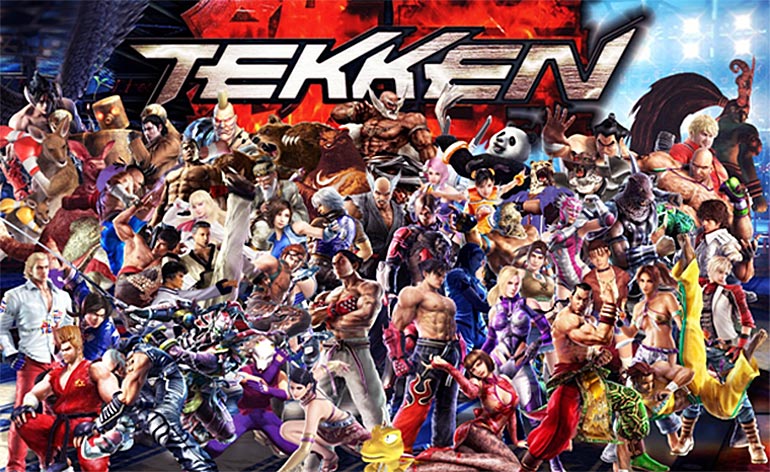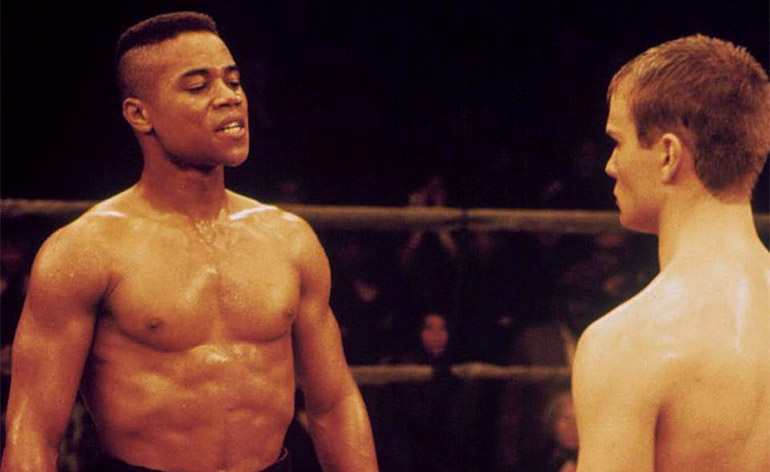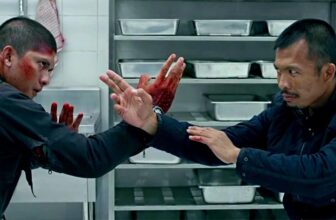
Gamers have a lot to be excited for this year, and one the main reasons is the upcoming release of the highly anticipated “Tekken 7”, the latest chapter in the ongoing video game franchise. Debuting in the mid-90’s the “Tekken” series has earned a well-deserved reputation as one of the greatest video game series ever created, widely recognized as one branch of what might be called the Holy Trinity of fighting games, alongside “Mortal Kombat” and “Street Fighter”!
This new installment of the series is said to bring the game’s ongoing blood feud between its three leading men, Jin Kazama, Kazuya Mishimaand Heihachi Mishima, full circle, along with delving into the origins of the curse of the Mishima family bloodline, the Devil Gene. Additionally, “Tekken 7” will also act as something of a crossover with the “Street Fighter” universe, with the villainous Akuma appearing in the game and reportedly playing a vital role in its story – and judging from the interactions he’s had with Heihachi thus far, it would seem they have a score to settle!
“Tekken 7” is set to arrive worldwide today on Playstation 4 and Xbox One gaming consoles, along with Microsoft Windows. Naturally, we at KFK feel that the arrival of a new chapter in the “Tekken” franchise must be commemorated appropriately, and what better way than to take a trip down memory lane through the entire “Tekken” series? So, strap on your red studded fighting gloves and prepare to summon the Devil Gene within you, readers – it’s time for a “Tekken” retrospective!
Tekken
“Tekken” first debuted in Japanese arcades in 1994 and was later made available for at-home gaming on the Playstation the following year. The story begins like something out of “Enter the Dragon”, with the ruthless Japanese tycoon Heihachi Mishima announcing the King of Iron Fist Tournament, with an enormous cash prize for the winner. What he doesn’t count on is that he’ll be faced by his own son, Kazuya. Decades earlier, Heihachi threw the five-year-old Kazuya off a cliff, believing that his son could only prove himself a worthy heir if he returns to the top. Heihachi thought his son perished in the fall, but Kazuya survived and has come to seek vengeance on his father – bringing with him the power of the Devil Gene -the mysterious curse of the Mishima family that Heihachi inadvertently awoke in the fall!
Upon its debut “Tekken” was an instant hit. Its shifting fighting plane and complex game play schematics presented a new and welcome challenge for fighting game aficionados who’d honed their skills with “Street Fighter” and “Mortal Kombat”. Additionally, some of the game’s most beloved and important characters would make their debut here, such as Paul Phoenix, the Williams sisters, Anna and Nina (whose own rivalry would become a staple of the “Tekken” universe)and Yoshimitsu, in addition to the obligatory Bruce Lee analogue, and owner of the best name ever bestowed upon a video game character, Marshall Law! Like Kazuya himself, the “Tekken” franchise was poised to conquer the world after its first installment and neither Bandai-Namco nor the series’ protagonist would waste any time at all in doing just that!
Tekken 2
Kazuya thought he’d finally achieved the vengeance he long dreamed of, after vanquishing his father at the King of Iron Fist tournament and assuming ownership of the Mishima Zaibatsu Corporation, but he soon realizes that survival runs in the Mishima family when Heihachi returns to claim what is his. Even worse, Kazuya is proving to be just as cruel and ruthless as his father once was in the same position; after the Devil Gene awoke inside of him, gradually beginning to turn him more and more to the path of darkness. The Mishima family also grows a new branch, after Kazuya fathers a child with animal rights activist Jun Kazama, who names their child Jin – a name that would become very familiar to “Tekken” fans in future Iron Fist tournaments.
It seems the fate of fighting games was sealed for the first sequel in a franchise to blow all expectations out of the water. “Tekken 2” certainly did exactly that with its expanded mythology that introduced the often quite grey morality of the leading characters that fans know very well today. The game would also incorporate new methods of gameplay, including Team Battle Mode, which allowed the player to swap between two characters in a single match (and later becoming the basis for the “Tekken Tag Tournament” series) and Survival Mode, where players attempt to battle as many successive opponents with just a single life bar to sustain them. Additionally, “Tekken 2” would not only carry over sixteen characters from its predecessor, but also introduce eight new fighters to the franchise, including Baek Soo Do, Bruce Irvin, Jack-2, the aforementioned Jun Kazama, Angel, Roger and Alex and last but not least, Lei Wulong, a Hong Kong-cop and exponent of Drunken Fist – after Marshall Law’s homage to Bruce Lee, it’s certainly not hard to guess who Lei was created in tribute to!
Tekken 3
The King of Iron Fist Tournament returned for another round with the chapter that would bring about the series’ status quo as we know it, “Tekken 3”. Set nineteen years after its predecessor, “Tekken 3” introduced a new slew of characters who would become both staples of the series and icons of fighting games, including Hwaorang, Julian Chang, Ling Xiaoyu, Bryan Fury, Dr. Bosconovitch, Mokujin, Ogre, Panda, the boxing dinosaur Gon, Marshall Law’s son, Forrest and Capoeira exponent Eddy Gordo. However, it was with the addition of the series’ new protagonist Jin Kazama that the storyline set up from the first game would finally reach its total fulfillment as the three-way vendetta between the Kazama and Mishima bloodline that fans associate with the series today.
“Tekken 3” would grow not only into one of the greatest successes for the series, but one of the biggest hits ever in the history of fighting games. The new gaming system allowed players greater control in side-stepping and dodging attacks, bringing the 180-degree rotation of the series’ fighting stages to its full potential. The game would also expand the mythology of the Devil Gene further than ever before, turning the new protagonist Jin into a conflicted anti-hero battling the dark force inside him, and introducing his more sinister alter-ego, Devil Jin. “Tekken 3” truly took the series to new heights of popularity and that momentum would continue right into the franchise’s next follow-up.
Tekken: Tag Tournament
Like every greater video game franchise, “Tekken” has seen its share of spin-offs, like the Pokemon themed “Pokken Tournament” and the Nina Williams solo adventure “Death by Degrees”. However, it is the “Tekken: Tag Tournament” that is remembered as the most emblematic of the series’ greatness, and rightly so. Drawing from one of the bonus features of “Tekken 2”, gamers were afforded a set-up straight out of a Pro-Wrestling Super Smackdown – with a pool of characters consisting of nearly every character introduced in the series up to that point, the “Tag Tournament” allowed players to pair up any two characters, which they could then switch back and forth with one another in each match!
The “Tag Tournament” proved so successful that a sequel was released in 2012, which similarly afforded players a massive pool of “Tekken” characters to mix and match. Although not officially in continuity with the main series’ story, gamers would get another glimpse of the evil lurking within the Mishima bloodline in the form of both games’ final boss, the mysterious Unknown, the sinister alter-ego of Jin’s mother, Jun Kazama. In a series that had previously given the world both new levels of complexity and finesse to the fighting game genre, and a gripping story of the world’s deadliest family feud, “Tekken: Tag Tournament” showed the world that the series still had plenty of tricks up its sleeve.
Tekken 4
The “Tekken” series would return in full force with 2002’s “Tekken 4”, with Heihachi still on his maniacal quest for immortality. He quickly realizes that the Devil Gene is the final missing piece of that puzzle, making his grandson, Jin, his target at the next King of Iron Fist tournament.
“Tekken 4” came about shortly after the debut of the Playstation 2 console, and its debut on the new platform treated gamers to a new leap forward in the quality of graphics and greatly finessed gameplay control that was a part of what brought video gaming into the mainstream in the early 21st century. Naturally, players were also treated to a brand-new set of added characters into the “Tekken” canon, such as boxer Steve Fox, towering Vale Tudo giant Craig Marduk, and Capoeira practitioner Christie Monteiro, the sister of Eddy Gordo.
Tekken 5
After a decade of an ever-expanding universe, story and character roster, the “Tekken” franchise would unleash arguably its most definitive title in the form of “Tekken 5”, which sought to take the series back to its roots and it most certainly did. The fighting system was designed to be the most fluid and streamlined yet in the series and the series’ famed “juggled attacks” were detailed more thoroughly to allow for easier use for gamers relishing the chance to keep their opponent in the air long enough to deliver half a dozen strikes!
“Tekken 5” would continue the series’ tradition of additional new characters in the newest installment, such as Ninjutsu master Raven, kung fu master Feng Wei, and a new final boss in the form of Jinpachi Mishima, Jin’s great-grandfather resurrected by the Devil Gene who serves as the game’s final boss. However, the story of “Tekken 5” would continue not only with the update “Tekken 5.1”, but also with “Tekken: Dark Resurrection”. Initially released for the Playstation Portable, and later ported to Playstation 3, “Dark Resurrection” would throw even more content and characters at gamers, such as French teenager Lili De Rochefort and Russian Sambo fighter Sergei Dragunov. “Tekken 5” truly was a gift that kept on giving.
Tekken 6
With “Tekken 6”, players would see Jin begin to travel down the same dark path that had consumed his father and grandfather. Now the head of Mishima Zaibatsu, Jin uses his newfound power in a bid to conquer the world. The war of the Mishima bloodline would reach right to the center of the global turmoil, with Kazuya having assumed control of Mishima Zaibatsu’s rival company, G-Corporation with Heihachi determined as ever to bring down two generations of the Mishima bloodline once and for all!
The character roster for “Tekken 6” was the biggest ever (with such new additions as Azazel, Alisa Bosconovitch, Miguel Caballero Rojo, and Heihachi’s other grandson, Lars Alexandersson) and owing to both the mainstream role video games had taken by the turn of the century, and the ever-improving nature of video game mechanics, made “Tekken 6” the series’ first title to be released for Xbox 360. “Tekken 6” would also receive its own update in the form of “Tekken 6: Bloodline Rebellion” bringing the “Tekken” story and Mishima family blood feud to where it currently sits before the release of “Tekken 7”. However, there would be one more battle before the next King of Iron Fist Tournament could commence…
Street Fighter X Tekken
If there’s one thing that fighting games beat all the competition at, its crossovers and few gaming crossovers bring a smile to players’ faces like “Street Fighter X Tekken”. Due to their radically different gameplay systems, the title effectively brings “Tekken” characters into the “Street Fighter” universe, affording players the chance to not only see fighters (who normally compete in the King of Iron Fist Tournament) receive a new digital makeover, but offer them the challenge of adapting the move set of a “Tekken” character to the layout presented in the “Street Fighter” series. As the title’s highly positive reception and sales figures can tell you, it’s a challenge that not many gamers felt like turning down.
“Street Fighter X Tekken” was intended to be the first of two games crossing over the two titles, the second being the as-yet-unrealized “Tekken X Street Fighter”, which would reverse the set up of the former and challenge players to adapt “Street Fighter” characters to the “Tekken” universe. While no official release date has yet been announced, the inclusion of Akuma in “Tekken 7” may prove to be an indicator that “Tekken X Street Fighter” may yet be on its way in the near future. Now, if someone at Bandai-Namco could just get the ball rolling on that “Tekken X Mortal Kombat” game we’ve all been waiting for…
So there you have it, our recap of the “Tekken” series, one of the greatest fighting-based titles ever to hit consoles in the history of video gaming! The only thing gamers have left to ask is: where does the “Tekken” story go from here? Well, you’ll just have to play “Tekken 7” when it hits gaming consoles this weekend to find out!






